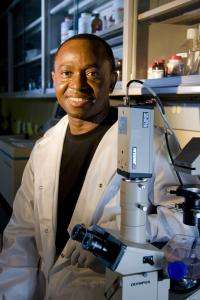Rogue bacteria involved in both heart disease and infertility

Outside the laboratory, Anthony Azenabor is outgoing and talkative, an extrovert who laughs heartily at his own jokes. But engrossed in his research, Azenabor is a shrewd and serious investigator who coaxes rogue bacteria to give up deadly secrets of how they cause several human illnesses.
Educated in Nigeria and Great Britain, Azenabor landed a fellowship sponsored by the World Health Organization soon after completing his doctorate on the bacteria Chlamydia. He was one of only two chosen worldwide.
Now an associate professor of health sciences at UW-Milwaukee, he has identified how two different kinds of Chlamydia can cause both coronary artery disease and miscarriages.
Solving one mystery gave him clues that he needed to figure out the other.
By focusing on the immune system mechanisms in Chlamydia infections, Azenabor has identified an important link in seemingly unrelated health problems.
The result could be new treatments and prevention strategies for both heart disease and infertility.
The first mystery
Chlamydia pneumoniae is a microbe that normally causes pneumonia and bronchitis, but it has long been associated with atherosclerosis, a cardiovascular disease also called “hardening of the arteries.”
“It was a frightening prospect,” says Azenabor, “that atherosclerosis could come from a bacterial infection.” He decided to look for an explanation.
Chlamydiae are unusual, says the Nigerian-born scientist, because, unlike most other bacteria, they use the same form of cholesterol for metabolism that human cells use. Chlamydiae also are intracellular pathogens, meaning that they can only grow and reproduce inside of another cell.
But these bacteria have another peculiar ability.
Normally, when a pathogen invades human tissue, the immune response unleashes “killer cells” called macrophages, which stretch to engulf the attacker and destroy it with toxin-producing enzymes.
Chlamydiae fight back, says Azenabor, His work shows that, as they are ingested, these two species of Chlamydia can manipulate the functions of protective cells like macrophages in creative ways.
Cholesterol connection
One of the keys lies in the macrophages’ cell walls, which store cholesterol and usually tightly control it.
But when it’s infected with C. pneumoniae, the microbe traffics cholesterol from the macrophage cell membrane to its own, causing a change in the macrophage that makes it rigid and unable to move.
The bacterium also disturbs the macrophage’s production of toxins in a process that transforms them into “signaling molecules,” which support functions that keep the bacterium alive.
“C. pneumoniae really wants to hijack the cell functions for its own use, like a parasite would,” he says. “The macrophage, though, wants to kill Chlamydia, but its killing ability has been converted to signaling.”
This is the reason the infection becomes chronic, Azenabor says. “Because of signaling, everything else in the human cell is still fine except for the altered toxins, so the bacteria can reproduce in a short time.”
As the macrophages become immobile, they accumulate in the blood vessel walls, setting the stage for atherosclerosis.
Infection and pregnancy
Armed with new information about how C. pneumoniae sabotages the immune response, Azenabor, who had also been studying the effects of estrogen on macrophages, turned his attention to another Chlamydia-related puzzle.
How is Chlamydia trachomatis, the species that causes a sexually transmitted disease, involved in the occurrence of spontaneous abortions or miscarriages?
He was immediately drawn to the protective cells in the placenta during early pregnancy – the trophoblasts.
“It’s not for nothing that trophoblasts are the early cells,” says Azenabor. “They prevent any kind of infection that could threaten the fertilized egg. They produce toxic chemicals similar to those of macrophages.”
Trophoblasts act like macrophages in many ways, and their functions are mediated by the hormones estrogen and progesterone. And cholesterol is the molecule used to produce those hormones.
Azenabor’s research shows that, like its cousin, C. trachomatis does take cholesterol from the trophoblast, and it also reproduces once inside the cell.
“It’s the same old story,” says Azenabor. “Only this time the attacked cell is a trophoblast instead of a macrophage, and the depleted cholesterol hinders production of estrogen and progesterone instead of altering toxin production.”
Azenabor’s lab members are continuing their inquiry, and they then will need to test the theories with live animals.
But the scientist is optimistic. Already he has a patented process for blocking the effects of calcium signaling for C. pneumoniae.
“If we can prevent C. trachomatis from becoming chronic, we could apply this remedy to pregnancy,” he says.
While conducting postdoctoral work at McMaster University in Ontario, he won the Canadian Distinguished Scientist Award in 1998, and moved to the University of Waterloo.
Azenabor joined the UWM faculty in 2001, after working as a scientist in a Chlamydia lab at UW–Madison. He jumped at the chance to start his own lab at UWM. Since arriving here he has won several honors, including the Shaw Distinguished Scientist Award from the James D. and Dorothy Shaw Fund in the Greater Milwaukee Foundation.
Although he didn’t plan on working with Chlamydia for this long, he is now a leading researcher in the field. One attraction, he says, is the work is unpredictable.
“When you begin,” he says, “you never know where you are going to go.”
Source: University of Wisconsin - Milwaukee





















